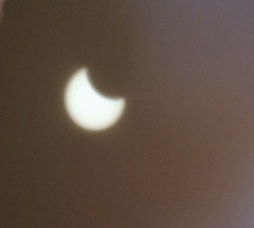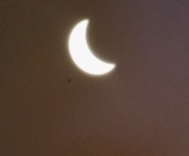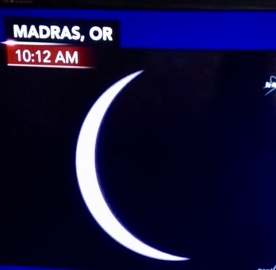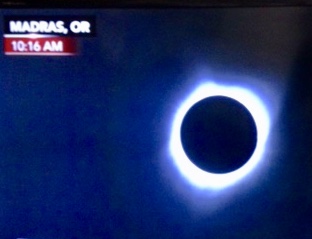UPDATE - EXPERIENCING A TOTAL SOLAR ECLIPSE
- Ron Hadfield
- Aug 28, 2017
- 5 min read
This blog was last published on August 21st, the day of the eclipse. However, today I received a fantastic photograph from a friend of Tracy's who is a professional photographer and I think many people will love to see this photo. His name is Tom Piekunka and his description of the experience is included below, along with his photo:
"I had the privilege to witness 52 seconds of totality during the recent solar eclipse while up in Redmond, OR with family and friends. Words cannot explain the eerie strangeness of night happening during the day. It was a remarkable experience!
Attached is the complete eclipse series taken at roughly 15 minute intervals. "First contact" (when the moon first touches the sun) happened at 9:06am. "Second contact" (when the moon fully covers the sun and begins Totality) happened at 10:25am. 52 seconds later came "third contact" (when the moon first leaves the sun, ending Totality) at 10:26am. "Fourth contact" (when the moon last touches the sun) happened at 11:41am, ending the eclipse cycle."

PREVIOUSLY PUBLISHED
On August 21st, the day of the actual event, a bunch of us gathered about 10:00 am high on a hill west of Garden City to watch the Solar Eclipse. When the state built a new highway west of Garden City, they cut through Ted's property (Bridgerland Village) and they exchanged some of Ted's land for a section that included the old highway. So Ted now owns a section of the old highway 89 and we felt that a certain spot on that old highway (Ted calls it Rocky Point) would be an excellent place to view the Eclipse. Our group consisted of Ted, Dixie and I, and a bunch of the Covert family; Quent, Barbara, Amy, Lesly and Cole. We all had special eclipse glasses. We set up a sun shade, table and chairs , a cooler with snacks and beverages, and sat back to watch the show. The photos below from left - Row 1: First is the old Highway 89 as you turn off the new highway; then the old Highway 89 looking back at the new highway; next me, Dixie and Ted when we arrived to set up "camp"; then more of the group with Bear Lake in the background.
Row 2: The first three photos are different shots of our group - Amy, Cole, Lesly, Barbara and Quent; then Amy, Quent, Barbara, Ted and Dixie; then Amy, Cole, Quent, Barbara, me, Dixie and Ted; the final photo is Amy after she put her jacket on - the temperature went from 74 degrees when we arrived to 63 degrees at the totality of the eclipse at our location.
Click Photo to Enlarge - Use Arrows for Next Photo
About 10:15 (Utah time) we began seeing a spot moving into the sun. We were all excited and sat back with our glasses on to watch. Admittedly it was a slow process and we took our glasses off several times to chat, but then looked again as the moon moved more and more in front of the sun. None of us were experts in getting photos of this event, but fortunately my girls are and sent us some photos by text. I have included a few of them below because they really represent what we were seeing and experiencing. Heather sent us the photos of the eclipse which she obtained using the "hole in a box" technique. Jenny sent us the photos taken of the coverage by Fox News. The whole event was really interesting to all of us, but I think the thing that surprised us the most was the change in temperature as the sun was covered. And secondly, we thought it would get somewhat dark, which it did not. The first three photos show the progressive move of the moon in front of the sun. As mentioned, these are photos sent to us by Heather, but they are the same as what we saw. The two photos from Jenny from Fox News are a little more totality than we saw where we were, but are really interesting to see.
Click Photo to Enlarge - Use Arrows for Next Photo
BELOW WAS PUBLISHED 8/14/17
I'm publishing this Blog a week prior to the actual event to provide information to those readers interested in the total solar eclipse that will occur on August 21st. You can learn more about the solar eclipse at the Griffith Observatory website by typing or pasting the following address in your browser: http://griffithobservatory.org/events/Solar_Eclipse_August_2017.html
A Wall Street Journal article on August 11 said, "On Aug. 21, the daytime sky will darken across 14 states, an event many stargazers have nicknamed the "Great American Eclipse." It is the first time since 1918 that an eclipse will spread from coast to coast in the U.S." The article went on to warn that special eclipse glasses must be used to prevent eye damage, and further, to be careful to buy glasses from legitimate optical-product manufacturers since glasses are being sold on the internet that do not meet the strict safety standards.
I will be in Garden City, Utah on August 21st to experience the total solar eclipse, and will re-publish this blog at that time to describe my actual experience. The research I have done indicates that we will experience the eclipse at 11:34 am and that it should be 96.05% totality.
============================
A Little Background: A total solar eclipse will take place on Monday, August 21, 2017. A solar eclipse occurs when the Moon passes between Earth and the Sun, thereby totally or partly obscuring the image of the Sun for a viewer on Earth. A total solar eclipse (Umbra) occurs when the Moon's apparent diameter is larger than the Sun's, blocking all direct sunlight, turning day into darkness. Totality occurs in a narrow path across the Earth's surface (about 70 miles wide), with the partial solar eclipse (Penumbra) visible over a surrounding region thousands of miles wide. The moon's shadow will move across the country West to East at a speed around 3,000 mph in Oregon and down to 1,500 mph in North Carolina.
The illustrations below were obtained from the Griffith Observatory's website. The first illustration shows the path of the eclipse across the country. Idaho Falls, Idaho, shown on the map, is in the path but south of the centerline. Victor, Idaho, where we had originally planned to go, is directly in the centerline. I will be in Garden City, Utah, which is about 150 miles south of the centerline, but well within the path where the eclipse can be seen. The duration will vary, but it will be the longest just south of St. Louis where darkness will last 2 minutes, 40 seconds. The second illustration shows how an eclipse happens, and the final shows how a total eclipse looks.
Click Photo to Enlarge - Use Arrows for Next Photo
State by state eclipse maps can be found at https://eclipse2017.nasa.gov/eclipse-maps












Comments